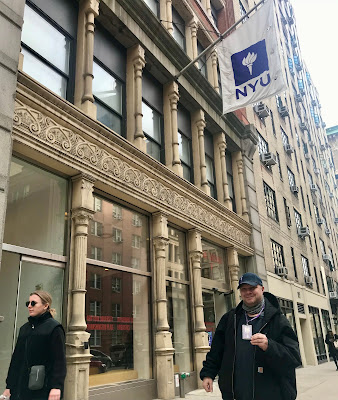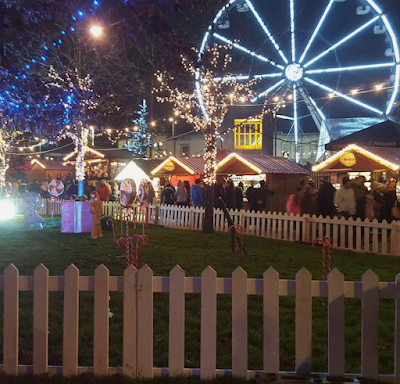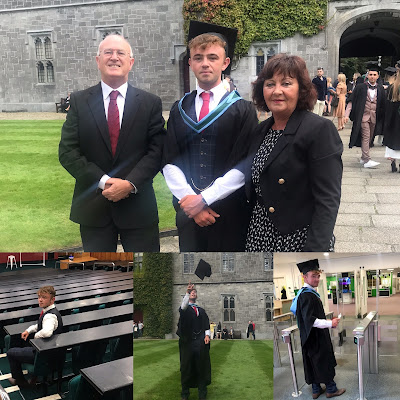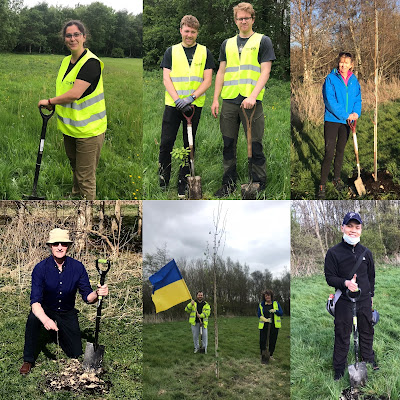My Writings (I hope!) reflect my Guiding Principles: -'Enjoy Life to the Utmost but not at other people's expense'-'Think Global, Act Local'-'Variety is the Spice of Life'-'Use Technology & Wisdom to Make the World A Better Place for All God's Creatures'-'Do Not Accept Injustice No Matter Where You Find It'-'Laughter is the Best Medicine'
Christmas 2022: The offspring of Santa Claus's favourite tree takes root in the soils of Terryland Forest Park!
An Irishman in New York City – The Big Apple is going Green!
New York City (NYC) is very special to me. As a city that I worked in during my student days at the height of the disco era it holds exciting memories of good times- for instance I saw the Bees Gees on stage in Madison Square Gardens during their Saturday Night Fever phase!
As a family we travelled to the Big Apple annually over the last few years except 2021 due to the pandemic. We were back this April and it was wonderful to see that, a place that had a reputation pre-2020 as “a city that never sleeps” finally, like so much of the rest of the world, woke up after its enforced COVID slumber.
Of course New York has serious social and economic issues which are well documented and highlighted by its own new breed of progressive radical politicians. But what fascinates me most with New York in the present era is its brilliant pioneering eco-projects. That is why I visit. Manhattan, whose streets were only a few years ago dominated by cars, is very quickly being immersed with a pedestrian and cycling infrastructure. The Gung-ho ethos in action. There is a greening of the city that is only made possible by grassroots NGOs, big business, large institutions and municipal government working towards a common goal of urban sustainability. If NYC can go green, blue and smart, then any city worldwide can. Shame on our Galway City Council for still promoting outdated and discredited transport strategies whilst failing to adequately protect and invest sufficiently in our public parks- the green lungs of the city.
More on the greening of the Big Red Apple in future postings.
But I also love visiting the USA to meet my American cousins. None more so than Ed Eccles, a true and honourable gentleman. New York suffered horribly during COVID with over 43,000 deaths. But Ed kept working throughout the crisis, travelling by train from New Jersey into the city on an almost daily basis working in maintenance at the New York University in downtown Manhattan helping to keep its systems operational. Thanks Ed.
An Irish Christmas, Past and Present
The spirit of caring and helping is symptomatic of a modern day Christmas with tens of millions of euros being collected for good causes every December in modern day Ireland. There is a wonderful emphasis on volunteering and taking part in fund-raising events to support those who are disadvantaged both at home and abroad. Inclusivity and diversity takes centre stage with children of special needs, disabilities, different ethnicity and faiths being given respect and prominence in the media such as on the Late Late Toy Show and other festive television delights. In Ireland the renowned generosity and openness of our people is there for all to see.
Colourful pop-up Xmas markets are hosted in every city enticing the visitor with amongst other things, live entertainment, an array of Irish handmade produce, fair trade gifts, mouth-watering craft beverages and tasty homegrown organic foods. Post-Ukrainian invasion, Irish towns and villages across the country are still decorated with colourful sparkling bunting and lights, and the gardens and buildings of some private houses look like Las Vegas at night-time.
Over the last few years, the Irish people have been encouraged to Buy Irish, Buy Local, Buy Sustainable, Buy Organic and support jobs and innovation in Ireland.
Thanks to online shopping and special festive product releases, the selection of toys for children as well as electronic gadgetry, clothes, toiletries and jewellery for adults has never been more wide ranging. A guilt-free happy consumerism ‘for good causes’ (family, friends, country, the economically disadvantaged and oneself) takes centre stage.
Post COVID, all age groups thankfully are once again celebrating at Christmas with their peers, from work parties for adults, to school concerts for children and parents, and clubbing/pubbing for the youth (& young at heart!). I myself enjoy organising a very special annual alcohol-free end-of-year multicultural party at my research institute paying homage to the rich culinary and other homeland traditions of our members. The cinemas, streaming and online media libraries such as Netflix as well as music services explode with much anticipated seasonal movies and music blockbusters. Though truth be told, the almost complete absence now of nightclubs in a Galway city famed for its ents is hard to believe.
Children happily write cards to Santa and more likely than not in Ireland he delivers their requested and oftentimes very expensive gifts. Boys and girls wake up early on Christmas morning to rush down to the tree to be overwhelmed with an array of toys. Thank you Santa!
But the most welcome characteristic of Christmas 2022 is the reappearance of the extended family coming together for Christmas. For the first time since 2019, parents, children, uncles and aunts are returning home from distant lands to spend the festive season with mothers, fathers, brothers, sisters, nieces, nephews, sons and daughters. In our case, our own youngest son Dáire came home to Ireland from Barcelona where he is studying medical science and in a few days I will travelling to the home of my youth in Carrickmacross to spend a few days with my brother Michael and to hopefully met a few friends from school days.
In times past.
Christmas during my childhood was more frugal, more serious, more religious, less bright and less festive than that of the 21st century. But it was nevertheless magical and wondrous for children then as it is for today’s young generation. But in a different way. In our household we try as with many other Irish families try to keep in 2022 some of these often millennia old traditions alive which have almost evaporated in the last few decades or where their true meaning has been for forgotten.
Part 2 to follow.
When We Were Young- the university campus of my Student Days
Mr Origami- A Veteran Star of the Galway Science & Technology Festival’s Sunday Fair
After being absent since 2019 due to COVID, the Galway Science and Technology Festival Fair made a welcome return to the University of Galway campus. Approximately 22,000 visited this major event in the Galway calendar, showing the appetite that people of all ages have for Science, Technology, Engineering, Arts and Maths (STEAM) in Galway city and county. This was probably our largest attendance ever!
What can Galway Learn from Belfast?
Goodbye dear Friend
With the passing of Michael Tiernan, Galway has lost one of its truest gentlemen and I have lost a dear friend.
Graduation Day- The End of an Era for our son, for his university and for his parents
A Crazy Irishman in Havana
1990s- Condoms, Gay Rights, Big Bands & the Guildford Four.
Racism, Sectarianism, Hatred, Imperial Triumpalism & Misogyny are Alive & Well in Northern Ireland
Community, Health & Environmental Success at 'Pride of Place' Awards.
The win by the Tuatha of Terryland Forest Park in the all-Ireland 'Pride of Place' awards in Killarney this week is dedicated to the tens of thousands of volunteers in Galway City of all ages and backgrounds who have over many many decades understood the critical importance of Nature for the health of the planet and the health of people, and that the battle to save the rainforests of Amazonia, the Congo and Indonesia will be fought and won in the cities of the world.
Little Schools are the Heartbeat of Rural Ireland & the Foundations for its Revitalisation
Planting a Ukrainian woods with an African connection and roots back to ancient Ireland within Terryland Forest Park.
The Tuatha volunteers have since mid March quietly planted a small woodland in Terryland Forest Park dedicated to the brave people of Ukraine who are suffering so much as they bravely resist Putin's brutal invasion.Only trees native to both countries were planted, namely oak, birch and alder.
We also had trees donated from the wonderful Self-Help Africa programme thanks to the generousity of Ronan Scully--, one of the great heroes of modern Ireland, whose work spanning two continents is based on implementing sustainability, environmental protection and community empowerment, combatting social exclusion and overcoming systemic poverty. The Self-Help Africa programme connects the planting of trees by schools in Ireland with reforestation in Africa. Ronan is also a worthy champion of the Galway National Park initiative. Thank you Ronan for all that you have been doing over many decades.
A Cycling & Walking Journey across the rural landscapes of Galway city & environs
A patriotic Green Irishman wears Blue & Yellow on St. Patrick's Day!
The Non-Irish Origins of St. Patrick's Day & 'All Things Irish'!
 St. Patrick himself is looked on as the personification of all that is Irish.
St. Patrick himself is looked on as the personification of all that is Irish.So for instance:
1. St. Patrick- British & Roman!
St. Patrick himself was actually Romano-British, the son of a Roman official that was taken as a slave by Irish sea raiders probably from near Carlisle (at Hadrian’s Wall) in northern Britain in the early 5th century. Even his adopted name is not Gaelic, coming from the Latin term ‘Patricius' (noble).
Yet, as we say in Ireland, the invader/foreigner oftentimes becomes 'more Irish than the Irish themselves' (except for a few Northern Unionists!). Though sent as a prisoner to Ireland & forced to work as a slave looking after sheep in the mountains, Patrick decided to return to Ireland as a Christian missionary years after his escape.
2.
 Guinness- Invented by Londoners & with some later support from the British Army!
Guinness- Invented by Londoners & with some later support from the British Army!'Guinness' was copied by Arthur Guinness from an 18th century London drink made out of roasted barley. The beer was known as ‘porter’ because it was originally popular with the porters (carriers) in Covent Garden. Arthur Guinness switched from producing the more common ale at his Dublin brewery. However Guinness was initially not well received with Dubliners because of the owner’s support for the British colonial regime and his opposition to the republican United Irishman during the rebellions of the late 1790s.
Guinness’ international reputation had also a lot to do with the British Army! In WW1, the high-energy consumption ‘porter’ breweries in mainland Britain were closed down by the government to concentrate the national energy resources on the armament production factories. However Guinness and the porter breweries in Ireland were allowed to stay open thus giving them a virtual trade monopoly in the then British Empire that stretched across five continents.
3. Irish Pub- Viking roots!

The 'Irish pub' was actually created by Viking invaders in the 9th century in their new slave-trading settlements of Dublin, Cork, Limerick etc. Common to all these Viking cities was the presence of a 'tavern' where Vikings, after grueling days or months spent fighting, raiding, pillaging or trading could come to enjoy the delights of beer, music and food served by gorgeous-looking Celtic wenches.
Over a thousand years later (in 1996), I returned the favour to our Viking brethren by managing the first Irish pub in Iceland- ‘The Dubliner’ in Reykjavik! (pubs were only legalized in that country in 1989)
4.
 'St. Patrick's Day Festival Parade’ -an American invention!
'St. Patrick's Day Festival Parade’ -an American invention!It originated in the mid-18th century American cities of Boston and New York where it was created by Irish Americans longing for their homeland and an opportunity to promote their heritage. The first parade took place in New York on March 17th in 1762 when it was led by Irish soldiers serving in the British Army! By the 19th century, it had became a powerful expression of Irish nationalism and the struggle against British colonial rule in Ireland.

5. Irish Whiskey -the essence of the Middle East!
The process of creating whiskey(from the Gaelic 'uisce beatha' = 'water of life') - 'distillation' was learnt from Coptic or Arab alchemists by studious Celtic monks. The former used it for medicinal purposes. However, we Irish soon saw its greater significance in the hospitality and entertainment sectors!
 6. Sexy Irish Traditional Dancing- another American invention!
6. Sexy Irish Traditional Dancing- another American invention!Traditional Irish step dancing only gained an international appeal in the 1990s thanks primarily to the efforts of an American, Michael Flatley.
This Irish-American from Chicago created the choreography for the 'Riverdance' show and, with fellow lead dancer Jean Butler, led the show to amazing success as the intermission act in the Eurovision Song Contest in 1994. Irish step dancing has never looked back since and Riverdance has generated a myriad of successful offshoots. Not only that, but the dour unsmiling
Irish dancers of previous eras were transformed into vivacious high-kicking Irish cailíní and buachaillí in figure-hugging attire. Furthermore, modern Irish dance now unashamedly embraces elements from other cultures (Russia, Arabian) increasing its international appeal even further.
Michael Flatley portrayed all that was good and important about Irish-Americans. When Irish traditions were dying out in the Emerald Isle, it was they that for centuries nurtured and kept alive the flame of Celtic culture.
7.
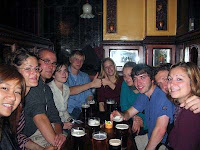 There is no such thing as Irish 'Craic'!
There is no such thing as Irish 'Craic'!'Craic' is looked on today as an Irish word denoting a quintessentially Irish form of fun (drink, music, amusing & friendly conversation).
In fact there was no such word in the Gaelic Language until the 1970s. It is actually an old English(!) word spelt 'crack' that meant in Elizabethan times 'to boast', 'to banter' or 'to tell a joke' as in the term 'to crack a joke'.
8. 'Irish Coffee'- invented for the benefit of American tourists suffering from the Irish weather!
On one cold evening in 1942 at a small windswept airport terminal on the west coast
 of
Ireland, the local chef felt pity for the tired and freezing passengers
who had just embarked from a seaplane that had to turn back from its
trans Atlantic journey due to atrocious weather conditions.
of
Ireland, the local chef felt pity for the tired and freezing passengers
who had just embarked from a seaplane that had to turn back from its
trans Atlantic journey due to atrocious weather conditions.Being Americans, he knew that they would enjoy a cup of hot coffee (not then much consumed by Irish people) topped with fresh cream. But because of the freezing conditions, he decided to spice it up with a shot of Irish whiskey. Legend has it that one of the passengers, remarking on the unusual taste of this drink asked, "Hey Buddy, is this Brazilian coffee?", to which the chef Joe Sheridan replied, 'No, that's Irish coffee'. And so, history was made!
9. Irish Songs-written by English, Americans, Scots & Australians!
 Many
of those great 'traditional Irish' ballad songs that are sung with such
gusto every night by broken-hearted inebriated Galwegians or Dubliners
in some Irish pub across the world were in fact written by English,
Scotch, Australian or American!
Many
of those great 'traditional Irish' ballad songs that are sung with such
gusto every night by broken-hearted inebriated Galwegians or Dubliners
in some Irish pub across the world were in fact written by English,
Scotch, Australian or American!10. Irish Traditional Music- reinvented by British Punks

It was a London-based Punk group of mixed English & Irish background that shook Irish music to its foundations and re-invented it for a modern Western youth audience. The anti-establishment Pogues, led by their brilliant lead singer and lyricist Shane MacGowan, that revitalised Irish music and brought vibrancy, youthfulness, relevancy and radical politics back into a staid Irish music scene.
Formed in 1982, the inventors of Celtic Punk fused traditional Irish folk with contemporary English punk and rock.
The name 'Pogues' comes from Pogue Mahone, the anglicisation of the Irish 'póg mo thóin,' meaning "kiss my ass".
As with Riverdance, their music was oftentimes condemned by the native Irish purists who preferred to keep Celtic culture in a sealed box untainted by outside forces.
Silly people! Like all cultures, Irish traditions are ever-changing, are constantly borrowing and being re-shaped by external influences.
 A traditional Irish (honest!) Toast
A traditional Irish (honest!) ToastIn honour of the day itself, may I send you all an old and heartfelt Irish blessing:
"May your glass be ever full,
May the roof over your head be always strong,
And may you be in heaven
half an hour before the devil knows you're dead!"

